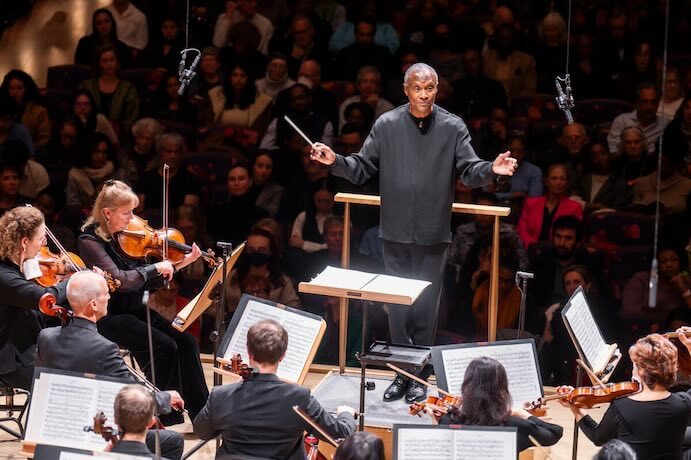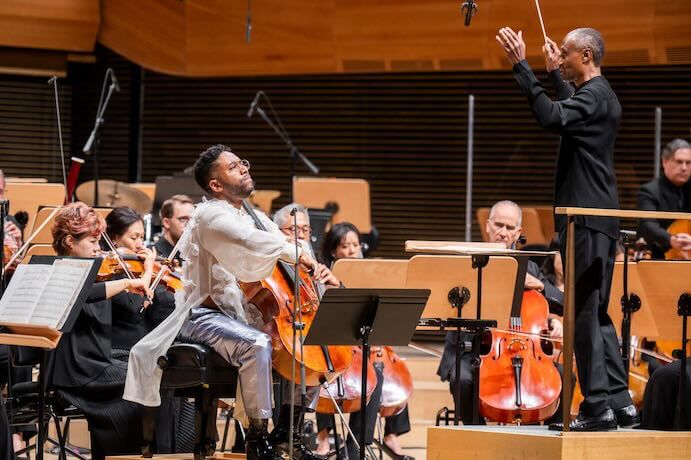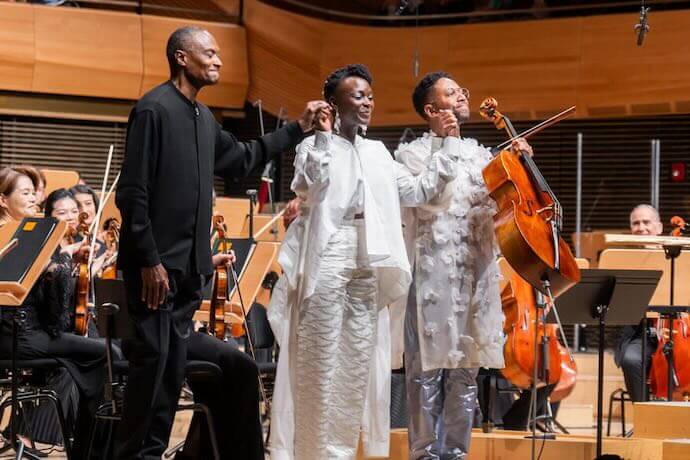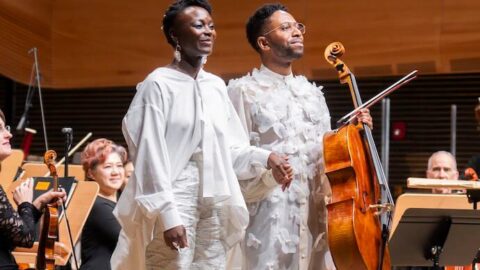In the Oct. 18 pre-concert talk on Afromodernism and music of the African diaspora at David Geffen Hall, the opening question didn’t ask what Afromodernism is, but rather, what the term “reveals, or helps us to see more clearly, in our creative expression and community practices.” Moderated by Fredara Hadley, an ethnomusicologist and professor at Juilliard, it was a welcome departure from the term itself — “loaded and ripe for argument,” Hadley noted — in which “questions of modernity, identity-making, and music-making are recurring ones that seem to be asked anew with every generation.” In other words, the pre-concert talk delved into what Afromodernism can bring to the field of classical music in its entirety, holistically — not just as representation on stage.
There is only one Black musician in the New York Philharmonic: principal clarinetist Anthony McGill. Black conductors like Thomas Wilkins, who led the evening’s concert, are a scarce sight on the podium. Cellist Seth Parker Woods, making his brilliant debut with the Philharmonic, was performing an enrapturing piece by composer Nathalie Joachim, also making her debut with the orchestra, despite being a staple of Lincoln Center programming for decades. David Baker’s piece was performed once before by the NY Phil 48 years ago on an educational concert, also conducted by a Black conductor, Everett Lee.
“It’s more than just putting us on stage; it is about making these spaces a home we can come to again and again and again — and not just on a few programs here and there,” Joachim said, noting the significantly more diverse audience in attendance. Those who frequently attend subscription season concerts certainly feel that sensation of home, but the audience that attended last week’s Afromodernism concerts wasn’t, by any close measurement, the same.

Afromodernism is characterized by the diaspora, by bits and pieces of Black musical expression once fragmented by colonialism through the Middle Passage. Monica L. Miller, Chair and Professor of the Africana Studies Department at Barnard College, described it as “when different Black modernisms meet each other in a diasporic space.” When music is regathered in diasporic spaces like symphony halls, it reflects how it exists in real life: collaged. Afromodernism isn’t a singular portrait of Black composers on one program, but a continual stitching of Black music into the fabric of the canon and contemporary works.
The concert began with Carlos Simon’s Four Black American Dances, which injects an African diasporic use of meter and instrumentation into the canon. “Ring Shout” began with heavy punches from brass and percussion, while “Waltz” floated rather than gliding, emphasizing the second beat of the triple meter to create a feeling of continual hovering. The anxious and jumpy “Tap” segued to the cut-time “Holy Dance,” capturing the freneticism, or Holy Spirit, contained inside each beat.
In her cello concerto, Had To Be, Nathalie Joachim meshed the unfamiliar, a particular quality of the diasporic experience. An off-stage brass section and snare drum – syncopated yet still dragging like a funeral march – tapered into lush, soft, legato strings pampering the orchestra. It started as a procession through town honoring the dead and eases into a community celebration of the life lost.
In the second movement, strings and vibraphone were pitted against drum set and brass while the solo cello remained inside the orchestra, never quite making it out until the final movement. In “Grace,” Woods waxed and shined poetic, aglow in Joachim’s stunningly crafted blinding light. The unresolved, continual climb to higher and higher notes with crotales, vibraphone, piano, and bells created a crystalline portrait of the sun reflecting and refracting on a calm stream in the woods. Joachim’s work weaves dissimilar sights and sounds into enchanting resonances that Woods beautifully channeled through his cello.

David Baker’s Kosbro is a marvel of a composition, requiring a well-executed blend, balance and rhythmic dexterity from the orchestra. Insistent percussion drills cut asymmetrically through avant-garde brass fanfares. Strings toppled into dissonant and elegiac serenades. Conductor Thomas Wilkins made jagged, metric phrasings that could have easily run amok absolutely pristine.
Concluding the program was William Grant Still’s Symphony No. 4, subtitled “Autochthonous,” a word that refers to Indigenous people rather than those descended from colonialists. Still described this work as a “fusion of musical cultures in North America,”and the symphony embodied the fragmented timelines of Afromodernism: the pre-colonial and pre-slavery Indigenous past, Still’s experience living through WWII, and the hoped-for Civil Rights Movement of the future.
Running through all the music was the collective weight of the stories the composers intended to tell, including Simon’s study of congregational worship and Joachim’s depiction of the funeral processions in Haiti and New Orleans. The solo cello was often expressed inside the orchestra, tasked with playing his way out of the ensemble rather than sitting above it by default. Percussion figured prominently—everywhere—more than the most grandiose uses of percussion across the Western canon. Brass dominated thematic material with fanfares as a foundation rather than for show; strings and woodwinds played with voices and textures usually relegated elsewhere.

Imagine these works played alongside their Western counterparts – what would that insight entail? As difficult as it may be to reconcile, concerts specifically dedicated to music of the African diaspora are as important as they are misguided. There should be, without a doubt, more Black musicians, conductors, and composers represented on stage – the thoughtful and illuminating artistry presented on this program was a testament to this.
However, when these artists are sectioned off on one program, it isn’t a study of Afromodernism. Music of the African diaspora can inform and challenge how we understand and listen to classical music, but only when it is presented as truly diasporic: spread abroad, and spread throughout the subscription season.
I CARE IF YOU LISTEN is an editorially-independent program of the American Composers Forum, and is made possible thanks to generous donor and institutional support. Opinions expressed are solely those of the author and may not represent the views of ICIYL or ACF.
You can support the work of ICIYL with a tax-deductible gift to ACF. For more on ACF, visit composersforum.org.
























